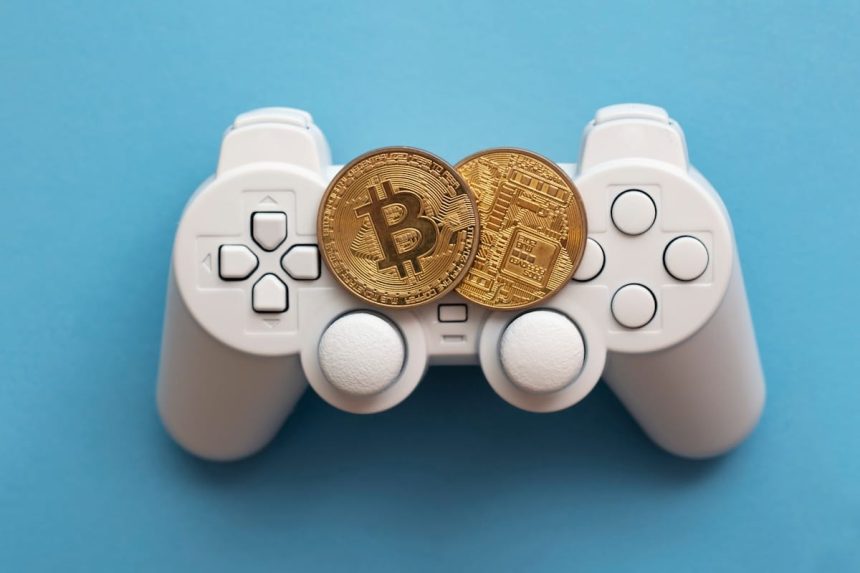The mainstream opinion says that crypto will change gaming forever, and GameFi will bring a billion users to Web3. But the reality is harsher; still, there is no genuinely mainstream Web3 game where users come to play, not to make money, and stay for a while. Let’s break down why this is the case and how soon that will change.
Key takeaways:
- Play-2-Earn games are popular among users, who essentially view these games as a form of labor today, not as an entertainment. This leads to failures in the long run.
- The core user base of all balanced and sustainable gaming systems are users who are willing to spend money in the game without expecting any financial refunds, as it is in the Web2 gaming.
- There are two ways for the GameFi industry to succeed: either a popular Web2-like AAA game project emerges, or there is going to be some innovative success within crypto gaming that is impossible to achieve in Web3.
- The adoption of cryptocurrency by one of popular gaming titles could become a trigger for the rest.
- Fully on-chain games is a new category of games that aims to create Autonomous Worlds, where all in-game logic, gameworld components, and rules are on-chain.
Current State of GameFi
You are probably familiar with the successful stories of Web3 games and the infographics showing their growth by one metric or another. There are two major problems with all of this:
- Metrics are highly volatile because they are created predominantly by farmers and sybils who are looking for profit rather than fun. And as soon as yields drop, they’re gone.
- Most of these metrics and success stories do not reflect the quality of games.
The most popular and successful Web3 game was once Axie Infinity, which at its peak in 2021 had 2.8 million daily players and generated more than $4 billion in transaction volume over the year. However, over the past month, the number of average daily users has not exceeded 25,000. And in reality, that’s a decent number. By comparison, The Sandbox has less than 5k daily players, and even that data is questionable. In November 2022 we posted the research, mentioning that The Sandbox and Decentraland both have about 500 daily active users.
Such Play-2-Earn games are predominantly played by users from economically underdeveloped countries, who essentially view these games as a form of labor today. More than 40% of all Axie Infinity players were from the Philippines, for example. “Play to Earn” is literally the core incentive, and that became the first iteration of the bad design issue.
The current GameFi landscape is a bit different. On average there are more users than before. But there is no dominant project that overshadows everything else, as was the case with Axie Infinity or Stepn. Notably, a couple of games from 2021 are still here: one of them is Farmers World, which keeps up with almost 300K monthly active users.
New Trend: Play To Airdrop
The second iteration of the bad design issue revealed itself after the start of the airdrop meta in cryptocurrencies, which has not left GameFi untouched. We can witness the already problematic Play-to-Earn model degrade to the Play-to-Airdrop model, where games have an even shorter lifespan. Players no longer need to play a game for a long time in order to earn a regular income; now all they need to do is play until the airdrop pays off for the time spent.
Most play-to-airdrop games will have a bright life before airdrop and a quiet death after. But not all of them; a few may succeed if they are able to marinate users in decent quality gameplay to motivate them to continue playing after airdrop. It’s too early to draw far-reaching conclusions, but Pixels, currently the hottest game in Axie Infinity’s Ronin chain, hasn’t lost any activity since the $PIXEL token airdrop on Feb 19th, and has even grown. However, we need to look at the dynamics of at least a few months to talk about success.Thus, the key problem with Web3 games is the design with bad incentives that fosters greed instead of desire to play.
What Makes a Good Game?
First of all, we should recognize the obvious fact that the mere presence of buzzwords like “crypto” and “Web3” in a game does not make it better. The vast majority of users come to Web3 games looking for profit (56%), and that should change.
The core user base of any balanced and sustainable game system consists of users who are willing to spend money in the game without expecting any financial return. These are users who want to play the game because they like the game itself, because they want to have a good time and have fun. These users will be willing to spend a lot of time fully immersed in the gaming environment, and will be willing to pay for in-game goods for reasons other than greed. Web2 gamers have been doing this for many years.
The specific reasons why people play games may be individual, but they are united by the fact that users go first and foremost for the game itself. It doesn’t really matter if it’s a web3 game or a regular one, it’s important to make it fun to play.
Web3 Gaming Landscape
The Web3 gaming landscape is already quite diverse, but there are two actual ways for the industry to succeed: either a popular Web2-like AAA game project emerges, or there is going to be some innovative success within crypto gaming that is impossible to achieve in Web2. In the first case, a really good game with a focus on gameplay and crypto integration on some level should arise, which will hit mass audiences and set standards for the rest. An innovative success could be the emergence of a fully on-chain game with a truly vivid economy. Naturally, some combination of these two ways is most likely, but for ease of perception, we have categorized game projects into Web2-like games and fully on-chain games.
Web2-like Games
The best scenario in this case would be if an already existing popular gaming franchise integrates cryptocurrency in some way. Last year, there were rumors that crypto and tokenization of things would be introduced in GTA 6. There’s no evidence of this so far, but this game franchise has always been a glimpse of American society, and Bitcoin is already a solid part of this society. Trying to speculate, if integration does happen, it will most likely be limited by the possibility of using BTC only in multiplayer mode. The adoption of cryptocurrency by one of such games could become a trigger for the rest.
List of possible AAA Games:
- Shrapnel. Shrapnel is a competitive AAA shooter by Epic Games set in the near future, where a mysterious substance has changed the balance of power as we know it. Launching on PC in 2025, this is one of the few crypto-related games that actually looks like an AAA project. The crypto-related part is based on one of the Avalanche subnets with a $SHARP token that will be integrated into the game as an in-game currency. Recently, released in early access.
- Illuvium. Illuvium is an open-world exploration space game with city building and PvP components, where players are trying to capture magical creatures called Illuvials. The game is built on Ethereum and is in open Alpha. The $ILV token allows participation in income farming, staking, and Illuvium DAO voting.
- Star Atlas. Star Atlas is a grand strategy game about space exploration, territory conquest, political dominance and life among the stars, built on Solana. In the Unreal Engine-based Star Atlas metaverse, one can build cities and create their microeconomics, fly space shuttles, mine resources, engage in warfare, create NFTs, and trade them. The game is in open Alpha with two tokens: $ATLAS for in-game interactions and $POLIS for DAO.
- Seekers of Tokane by Aurory. Seekers of Tokane is a retro-futuristic adventure game in the Aurory universe that combines exploration and battles, built on Solana. Players can explore the Aurory universe populated by Nefties creatures, collect and trade unique NFTs. The game is in open Alpha with a $AURY token.
Autonomous Worlds
Fully on-chain games are a new category of games that aims to create so-called Autonomous Worlds, where all in-game logic, gameworld components (items, characters, locations), and rules (synergy of components) are on-chain. Within such games, everyone can create a fork of the game with its own rules. Also, any in-game asset can be wrapped and turned into a derivative to be used in built-in mini-games, in other games, or in DeFi. Thus, the economy of one game can be connected to other games, which in theory allows the creation of a shared game universe with aggregated traffic. In other words, “Autonomous Worlds are not just worlds that happen to exist on-chain, but worlds that could not exist otherwise”.
The vast majority of innovation, including GameFi, is happening on Ethereum, and despite the myriad of Layer 2s emerging from all over the space, the problem of scalability and price efficiency is far from being solved. Thus, most of the projects are either in the concept stage or in early alpha, so there are a lot of opportunities to become an early adopter.List of Autonomous World Games Projects:
- The first Autonomous World game was Dark Forest, the real-time strategy (RTS) game, which appeared in 2020 on Ethereum. In the game, players compete for planets and resources, using ZK-SNARK to keep coordinates secured and verify actions. One can play individually or join a guild to conquer other planets and claim dominance. There is no token.
- The Citadel. The Citadel is a 2D strategy space game on Ethereum and Polygon, where players pilot pixel spaceships across an on-chain star map to fight or collect resources. Currently, on closed devnet without a token.
- Realms: Ethernum. Realms: Ethernum is an economic strategy game inspired by the Age of Empires and Civilization from the Bibliotheca DAO team. The Starknet-based team is building not only a game but also a game engine to run such games on. The game is live in open alpha with the token $LORDS.
- Influence. Influence is a MMORPG space strategy game on Starknet where one can colonize, mine resources, wage wars, and forge alliances. The game is live on limited release without a token.
- Briq. Briq is a block-building adventure game similar to LEGO, based on Starknet. The key components of the game are briqs, which are building blocks stored on the blockchain and can be minted for ETH or bought on a marketplace. On the technical side, briqs are ERC-1155-compliant tokens. One can build any structure from briqs or buy a Briq kit to build a specific model according to a blueprint. The game is live in open Alpha.
- OpCraft. Opcraft is a craft-based game on Optimism by Lattice. The game itself isn’t particularly noteworthy, being another copy of Minecraft, but the studio that created it considers this its test product. Lattice is building a game engine for on-chain games called the MUD engine.
- Sky Strife. Sky Strife is a PvP RTS game where players compete for control of islands. It is the second project by Lattice on Optimism. Currently, it is under development.
- Lorak. Lorak is the meta-game of the LandTorn universe, built by the LandTorn gaming studio and platform on the Base Chain. The game is set in a classic medieval fantasy setting with a heavy emphasis on Lore. Players go through dungeons and try to obtain $SHARD tokens and valuable items, which can then be exchanged for $TORN tokens.
- Pirate Nation. Pirate Nation is a pirate-themed RPG game on Ethereum and Arbitrum Nova, where players send their pirates on expeditions to fight monsters, gather loot, etc. Currently, it is in Beta without a token.
- Mithraeum. Mithraeum is a grand strategy game on the Gnosis Chain where the players have to develop settlements, trade resources on the market, build a powerful army, and raid other settlements on one global map. Currently, in Alpha testnet, where players can participate in tournaments and qualify for tokens, those tokens will be distributed upon token launch.
Output
In the following years, we are likely to see a lot of experiments in Web3 gaming that will reveal what works and what doesn’t. In the coming bull market, we expect to see a huge inflow of speculative capital into these experimental games, helping and sometimes hurting them to come up with viable products. Probably, games that put the financial component first and the gaming component second will die. Those projects that focus primarily on creating a proper game with high-quality gameplay will prevail and thrive, assuming, of course, that they can compete with Web2 games. Projects by established game studios will most likely have the upper hand here.
Successful mass-user Web3 games will hardly differ from Web2 games in terms of user experience. There, blockchain will probably become just another layer that solves the problems of closed code, centralization, non-interoperability of in-game items, etc. while remaining in the background. At the same time, we see the emergence of a new category of fully on-chain Autonomous Worlds, which are unlikely to attract a mass market but likely forge a special niche unavailable to Web2.
Disclaimer: The text above is an advertorial article that is not part of Cryptonews.com editorial content.
Read the full article here




